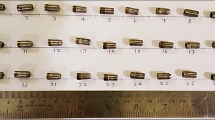Abstract
Hydroxyapatite bio-ceramics are used for producing implants for bio-medical applications. The generation of hemispherical shaped cavity on hydroxyapatite bio-ceramic is highly demanded for making hip joint. Ultrasonic machining is suitable for the machining of all kind of hard and fragile materials, which are electrically non-conducting. This paper is aimed to design and develop a tool and holding arrangement in ultrasonic machining (USM) for generating hemispherical shaped cavity on hydroxyapatite bio-ceramic which is highly demanded for hip joint replacement. This paper also includes the study of the influences of process parameters such as abrasive grain diameter, abrasive slurry concentration, tool feed rate and power rating on material removal rate, diametrical deviation, and circularity error during ultrasonic machining. From the basic parametric studies, it is observed that the abrasive grain diameter, power rating, and tool feed rate are the most important parameters, which have greater influence on the material removal rate (MRR), diametrical deviation, and circularity error of hemispherical cavity on hydraxyapatite bio-ceramics. It is also concluded that the hemispherical shaped cavity on hydroxyapatite bio-ceramics with dimensional accuracy can be generated by USM with the aid of developed tool geometry and proper control of process parameters during ultrasonic machining.
Similar content being viewed by others
References
Sun HB (2010) Mechanical loading, cartilage degradation, and arthritis”. Ann N Y Acad Sci 1211(1):37–50
Grigoris, P. Amstutz, H. C. Fowble, V. A. (1998) "Precision-fit surface hemiarthroplasty for femoral head osteonecrosis", in Hip Surgery: Materials and Developments
VanPutte C, Regan J, Russo A (2010) Seeley’s essentials of anatomy and physiology”, 7th edn. The McGraw-Hill Companies Inc., New York
Revell PA (ed) (2008) Joint replacement technology”. Woodhead Publishing Limited, Cambridge, UK, pp 83–84
Makela K (2007) Lonkan tekonivelmallit”. Niveltieto 2:14–15
Pluot E, Davis ET, Revell M, Davies AM, James SLJ (2009) Hip arthoplasty. Part 1: prosthesis terminology and classification”. Clin Radiol 64:954–960
Rao RV, Pawar PJ, Davim JP (2010) Parameter optimization of ultrasonic machining process using nontraditional optimization algorithms. Mater Manuf Process 25:1120–1130
Dvivedi A, Kumar P (2007) Surface quality evaluation in ultrasonic drilling through the Taguchi technique. Int J Adv Manuf Technol 34:131–140
Kumar J, Khamba JS (2010) Modeling the material removal rate in ultrasonic machining of titanium using dimensional analysis. Int J Adv Manuf Technol 48:103–119
Kumar J, Khamba JS, Mohapatra SK (2009) Investigating and modeling tool-wear rate in the ultrasonic machining of titanium”. Int J Adv Manuf Technol 41:1107–1117
Bertsche E, Ehmann K, Malukhin K (2013) Ultrasonic slot machining of a silicon carbide matrix composite. Int J Adv Manuf Technol 66:1119–1134
Miller GE (1957) Special theory of ultrasonic machining. J Appl Phys 28:149–156
Nath C, Lim GC, Zheng HY (2012) Influence of the material removal mechanisms on hole integrity in ultrasonic machining of structural ceramics. Ultrasonics 52:605–613
Shaw MC (1956) Ultrasonic grinding. Ann CIRP 5:25–53
Mary A, David M, Moore O (1988) Versatile performance of ultrasonic machining. Ceramic Bull 67(6):1045–1047
Dam H, Quist P, Schreiber MP (1995) Productivity, surface quality and tolerances in ultrasonic machining of ceramics. J Mater Process Technol 51(358):368
Komaraiah M, Manan MA, Reddy PN, Victor S (1988) Investigation of surface roughness and accuracy in ultrasonic machining. Precis Eng 10:59–68
Hocheng H, Kuo KL, Lin JT (1999) Machinability of zirconia ceramics in ultrasonic drilling. Mater Manuf Process 14:713–724
Lalchhuanvela H, Doloi B, Bhattacharyya B (2013) Analysis on profile accuracy for ultrasonic machining of alumina ceramics. Int J Adv Manuf Technol 67:1683–1691
Jianxin D, Taichiu L (2002) Ultrasonic machining of alumina-based ceramic composites. J Eur Ceram Soc 22:1235–1241
Lalchnuanvela H, Doloi B, Bhattacharya B (2012) Enabling and understanding ultrasonic machining of engineering ceramics using parametric analysis. Mater Manuf Process 27(4):443–448
Das S, Doloi B, Bhattacharyya B (2013) Optimisation of ultrasonic machining of zirconia bio-ceramics using genetic algorithm. Int J Manuf Technol Manag 27:186–197
Thoe TB, Aspinwall DK, Wise MLH (1998) Review on ultrasonic machining. Int J Mach Tools Manuf 38:239–255
Wang X, Zhou M, Gan JGK, Ngoi B (2002) Theoretical and experimental studies of ultraprecision machining of brittle materials with ultrasonic vibration. Int J Adv Manuf Technol 20:99–102
Ghahramani B (2001) Precision ultrasonic machining process: a case study of stress analysis of ceramic (Al2O3). Int J Mach Tool Manuf 41:1189–1208
Instruction Manual for All Stationary Sonic-Mill Models (2005) Sonic-Mill, New Albuquerque, New Mexico, USA
Author information
Authors and Affiliations
Corresponding author
Rights and permissions
About this article
Cite this article
Das, S., Kumar, S., Doloi, B. et al. Experimental studies of ultrasonic machining on hydroxyapatite bio-ceramics. Int J Adv Manuf Technol 86, 829–839 (2016). https://doi.org/10.1007/s00170-015-8226-4
Received:
Accepted:
Published:
Issue Date:
DOI: https://doi.org/10.1007/s00170-015-8226-4




